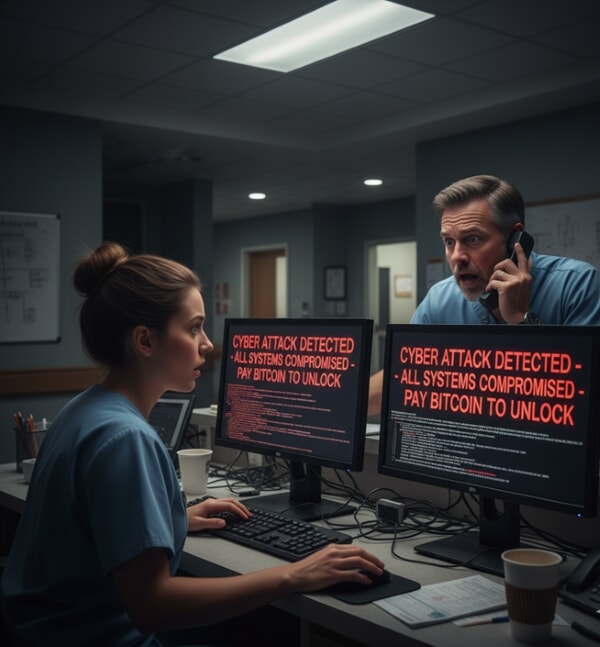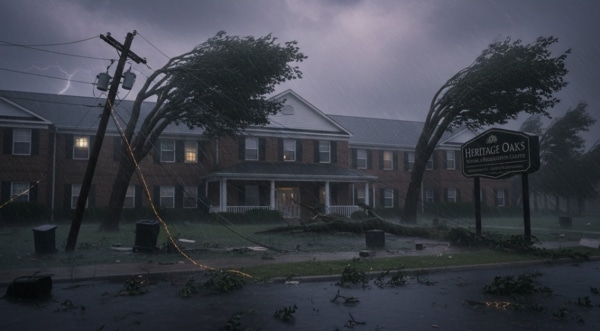Disaster-Proof Tech: How Long-Term Care Facilities Keep Your Parent Safe

Table of Contents
- Why This Matters to You
- What Strong Preparedness Looks Like
- What To Ask Before Choosing an LTC Facility
- Family Checklist: Questions to Ask During a Tour or Care Conference
- The Hidden Hardware That Protects Your Parent
- Cyber Incidents Are Disasters Too
- What if a Facility Falls Short?
- Planning Beyond the Building
- A Quick Script You Can Use
- Bottom Line
If your mom or dad lives in a long-term care facility or may need to transition to one in the future, you expect care to continue even if the power flickers, the internet fails, or a storm blows through.
The quality of consistency of the care matters. You deserve calm, not chaos, when emergencies happen. You want nurses to see vital signs, find medication orders, and reach 911 without delay. That calm often depends on something you rarely see: resilient cabling and backup systems that keep electronic health records (EHR), monitoring, and communications online when trouble hits.
These attacks often impact mission-critical medical and information technology, resulting in the disruption of care delivery and possible risk to patient safety. — John Riggi, national director for cybersecurity and risk at the American Hospital Association, on a Joint Commission alert.
Why This Matters to You
Modern facilities rely on networks for almost everything: heart and oxygen monitors, medication administration, nurse call buttons, and telehealth consults. When cabling is built with fire-resistant, water-tolerant materials and redundant pathways, critical systems can keep running during outages or cyber incidents.
The Joint Commission and AHA urge providers to plan for “clinical continuity” and be ready to operate offline for extended periods if necessary. That mindset protects residents when minutes matter.
What Strong Preparedness Looks Like
Emergency-ready facilities follow federal standards and test them. The Centers for Medicare & Medicaid Services (CMS) require participating providers, including nursing homes, to maintain an all-hazards plan, communication plan, policies and procedures, and training and testing.
Ask how the home meets those four core elements and how technology fits in. Electronic Health Records (EHR) must have downtime playbooks and drills. Health-care preparedness guidance highlights routine staff training, clear “downtime start” triggers, and triage workflows that keep care safe when systems go dark.
Facilities in disaster-prone areas report real challenges, especially staffing during emergencies and evacuations. That is your cue to probe how a home plans, trains, and practices. There are an increasing number of emergencies that can happen, from the weather, internet outages, or cyber-attacks, these are real concerns.

What To Ask Before Choosing an LTC Facility
When you’re searching for a long-term care facility for a parent or loved one, you’re likely focused on the essentials, including staffing, care quality, meals, cleanliness, activities, and location. But in today’s world, technology resilience is just as critical. It’s the hidden infrastructure that ensures your loved one receives uninterrupted care in a crisis.
Here are key questions families should ask during tours or interviews with facility administrators:
Technology and Power
- How does the facility keep medical equipment, call systems, and electronic health records running during power failures? Do they incorporate redundant power supplies that utilize uninterruptible power supplies (UPS) to maintain power during outages, ensuring that their systems remain operational?
- What kind of backup power systems (generators, UPS) are in place, and how often are they tested?
Cabling and Network Redundancy
- Are the data and communication networks designed to remain operational during storms, fires, or other emergencies?
- Are redundant network pathways in place to avoid a single point of failure?
Emergency Communications
- How will the facility contact families if phones or the internet are down?
- How are alarms and alerts transmitted during emergencies?
Cybersecurity and Downtime Protocols
- What happens if the electronic health record (EHR) system goes down due to a cyberattack or outage?
- How often does the staff train for these scenarios?
Drills and Documentation
- Can the facility provide documentation or reports of recent emergency drills?
- How is staff performance evaluated during these drills?
Cyber-attacks are in the news all the time, and they can shut down care facilities, erase health history, and put patient health and identity at risk; thus, cyber safety is patient safety.
A quality long-term care facility has considered all these types of disasters because its residents and staff demand them. Many facilities partner with providers that specialize in Data Center Cabling Solutions, which can help them design a network that remains resilient even under extreme conditions.
- Tip: Bring these questions with you on a clipboard or phone. Clear, confident answers are a sign the facility takes resident safety seriously. Vague responses or “we’ve never had that happen” are red flags.
👉 You can use the LTC News Caregiver Directory to find long-term care facilities and home care agencies in your area. This allows you to compare not just services, but also how prepared different organizations are for real-world emergencies.
Family Checklist: Questions to Ask During a Tour or Care Conference
Set the tone with simple, direct questions. You do not need to be a network engineer.
- Redundancy: If one cable route fails, does a second route keep HER and monitors live? How is internet redundancy handled?
- Power: Which systems ride on uninterruptible power supplies (UPS), and for how long? What is the generator test schedule?
- Downtime Drills: When was your last HER downtime drill? Who declares downtime, and who leads communication to families?
- Fire and Water Resilience: Are communications cables fire-resistant and low-smoke in plenum spaces? How are network closets protected from leaks and floods?
- Communication Plan: How will you reach me and emergency services if phones or the internet fail? Show me your backup method.
The Hidden Hardware That Protects Your Parent
There are things you don’t see that are as important as the care itself. You will hear terms like plenum-rated cable (fire-resistant, low smoke in air-handling spaces) and fiber optic (high bandwidth, immune to electrical interference). Both help networks stay stable during heat, smoke, or electrical noise. Proper selection and installation reduce fire risks and keep signals clean during stress.
Redundant pathways matter as much as cable type. Separate routes mean a single cut or flood does not take everything down. Coupled with UPS and generators, redundancy buys time for staff to keep care moving, even offline.
Cyber Incidents Are Disasters Too
Ransomware can cripple hospitals and nursing homes. National guidance now treats cyberattacks like any other hazard. Facilities should pre-assign a “trigger person” to declare downtime, run paper workflows safely, and keep families informed.
Expect them to train for several-week disruptions—yes, weeks. Ask how they would care for your parent if systems were offline.
What if a Facility Falls Short?
Federal watchdogs have documented gaps in preparedness and infection control over the years, although many homes have improved since COVID-19. Your questions can spotlight whether a facility has moved from paper plans to practiced readiness.
Consider this your safety net: talk with staff leaders, request to see drill records, and ask to observe a tabletop exercise if possible. If answers are vague, keep looking.
Planning Beyond the Building
A strong facility plan is one layer. Your family plan is next.
- Know the local costs of alternative extended care in other areas if evacuation or relocation is needed. Use the LTC News Cost of Care Calculator to compare home care, assisted living, and nursing home rates in your area.
- Identify backup caregivers using the LTC News Caregiver Directory so you have names and numbers ready if services are disrupted.
- Review insurance. If your loved one has a Long-Term Care Insurance, confirm how benefits work during evacuations or temporary placements. LTC policies are portable, so if a loved one has a policy paying benefits, those benefits will transfer without much difficulty.
You can also explore the LTC News Education Center for planning guides and family checklists you can review.
A Quick Script You Can Use
Try this on your next call or care meeting at a loved one's long-term care facility:
Can you walk me through how EHR and monitoring stay up if we lose power or internet? Who declares downtime, how often do you drill it, and how will you contact me?
Bottom Line
You cannot control the weather or stop every cyberattack. You can choose a facility that plans, tests, and invests in resilient technology. Ask direct questions. Look for proof. Your parent’s safety depends on systems that work when everything else does not.
Being prepared will ensure quality care and safety for someone you love. Thinking about being prepared, be sure to consider your future aging and need for long-term care services at home or in a facility. The cost of extended care will rise dramatically in the decades ahead. Be sure to get quotes for Long-Term Care Insurance now, before you retire, so you and your family are prepared for the costs and burdens of aging.


